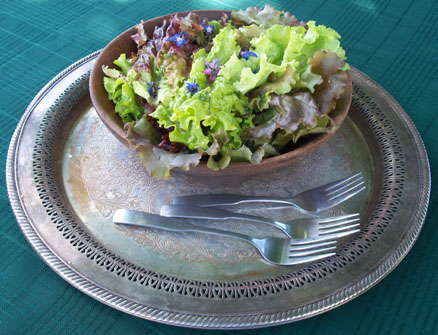| Main Recipe Index |
|
A Twelfth Century German Salad? |
|||
| Articles |
The inspiration comes not from a ‘cookbook’ but from a treatise on the medical application of various plants, animals and other substances. Physica was written between 1151- 1158 by Hildegard von Bingham, a German nun. She was a remarkable woman, well known as a religious mystic, and at one point in her life established her own convent. While the Physica concentrates on the uses of plants and animals in medicinal preparations, Quite a number of entries give us clues to what was being eaten and even some hints towards recipes. This is not surprising as diet was considered an intricate part of medicine and health maintenance. This entry on domestic lettuce gives some very clear clues. Domestic Lettuces (latich), which can be eaten, are very cold. Eaten without condiment, their injurious juice makes a person’s brain empty, and they fill his stomach with illness. Whence, one who wishes to eat it should first temper it with dill, vinegar, or garlic. So that these suffuse in it a short time before it is eaten, Tempered in this way, lettuce strengthens the brain and furnishes food digestion. For our salad we start with some leaf lettuce. I am fortunate to deal with a farmer who grows many heirloom varieties including this one dating to 1750. Then dress it with a simple dressing of vinegar and oil, with garlic, dill and a bit of salt. The final garnish of borage flowers (home grown) was suggested by a painting Still Life with Flowers and Refreshments by Georg Flegel (1563-1638)
Bibliography Bingen, Hildegard von. Hildegard von Bingen's Physica. Trans. Priscilla Throop. Rochester: Healing Arts Press, 1998.
|

Other Salads
Other German Dishes
. |
|||
| Stuff Mateusz Made for the Kitchen | |||||
| About the Cook and Author | |||||
| Welcome Page | |||||
| Dragons Laire Culinary Guild | |||||
| Feast Menus | |||||
| Categorical Recipe Index | |||||
